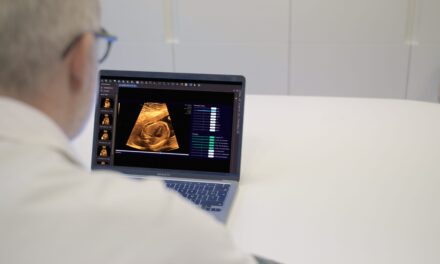AI is streamlining maintenance and predicting failures before they happen. But without the right safeguards, it could create more problems than it solves.
Interview by Alyx Arnett
From backlogged work orders to the growing complexity of medical equipment repairs, healthcare technology management (HTM) teams are under constant pressure to keep devices running while managing limited resources. Artificial intelligence (AI) is emerging as a key tool to improve efficiency and reduce the strain on overburdened teams.
Crothall Healthcare’s Healthcare Technology Solutions (HTS) division is already seeing AI’s impact in the hospitals it serves. One team lead reported a 30% reduction in backlog within just a few months, “giving them breathing room to focus on big-picture maintenance rather than drowning in tickets,” says Dan Miles, senior director of technology systems at Crothall HTS.
Additionally, AI-driven tools have reduced repair times by 39% and improved accuracy by 21%, allowing technicians to diagnose and address issues more effectively, according to the 2025 Field Service Benchmark Report by Aquant, which analyzed nearly 160 service organizations across industries.
At the same time, AI introduces new risks. ECRI’s Top 10 Health Technology Hazards for 2025 identified AI as the top concern, warning that misleading outputs, embedded biases, and cybersecurity vulnerabilities could impact patient safety. Without proper oversight, AI-generated recommendations could lead to errors in equipment maintenance or security gaps that expose sensitive data.
So, how do HTM teams harness AI’s potential while avoiding its pitfalls? Miles shares his perspective on where AI is making an impact, where it could go wrong, and how healthcare organizations can adopt it responsibly.

24×7: ECRI recently identified AI as the top health technology hazard for 2025. What are the most significant security risks AI presents in HTM, and how can healthcare organizations mitigate these challenges?
AI’s rise in healthcare technology management brings powerful capabilities, but ECRI does flag some real and present risks. The biggest security concerns include data breaches from AI systems handling sensitive patient and equipment data, flawed decision-making from poorly trained models, and vulnerabilities to cyberattacks exploiting AI’s complexity. Imagine an AI misprioritizing equipment maintenance due to biased data or a hacker manipulating an AI-powered diagnostic tool—both could disrupt care and erode trust.
Mitigation starts with rigorous validation. Organizations must test AI models thoroughly before deployment, ensuring they’re trained on diverse, accurate datasets. Strong encryption and access controls can shield data, with regular audits. Pairing AI with human oversight ensures accountability, blending tech innovation with healthcare’s cautious standards. But testing doesn’t stop at launch. Ongoing validation is essential to maintain accuracy and reliability as systems evolve.
Our approach prioritizes cybersecurity through strong encryption, multi-factor authentication, and strict access controls. These measures, combined with regular system audits, allow us to identify and address potential vulnerabilities.
24×7: Aquant’s 2025 Field Service Benchmark Report revealed that AI enables faster and more accurate repairs. How do you see AI balancing its benefits—such as predictive maintenance and workflow optimization—while addressing the security and reliability concerns raised by ECRI?
Aquant’s findings spotlight AI’s knack for speeding up repairs and boosting efficiency—think predictive maintenance flagging a failing MRI coil before it breaks or workflow tools routing technicians smarter. These wins save time and money, letting HTM teams focus on patient care. But ECRI’s concerns loom large: Unreliable AI predictions or hacked systems could undo those gains, turning a helpful tool into a liability.
The balance hinges on design and discipline. AI systems need built-in reliability checks like cross-referencing predictions with historical data and robust security layers to fend off threats. Training staff to spot anomalies keeps the human element strong. It’s about harnessing AI’s speed without letting it run wild. Think of it as a high-performance car with top-notch brakes.
24×7: How is AI-driven predictive maintenance changing how frontline HTM professionals manage assets? Can you share examples of its impact in real-world settings?
AI-driven predictive maintenance is flipping the script for HTM pros. Instead of reacting to breakdowns, they’re preempting them, using AI to analyze equipment data and predict failures. This shift frees frontline teams from having to operate in firefighting mode, allowing them to plan repairs strategically and keep critical assets like ventilators or imaging machines available.
“Over the next five years, AI in HTM will mature from a flashy experiment to a core ally.”
Dan Miles, Crothall hts
Take a busy hospital: AI might notice subtle vibration changes in a CT scanner, signaling a bearing issue days before it fails. As a result, techs can schedule downtime during a slow shift. Or consider a rural clinic where AI flags a pump motor’s wear, prompting a fix before it breaks down and disrupts care. These real-world wins cut downtime, stretch budgets, and, most importantly, keep patients safe.
24×7: Managing work orders efficiently is a challenge in HTM. How is AI optimizing work order management, and what benefits are HTM professionals seeing in workflow automation and response times?
Work orders in HTM can be a logistical nightmare with hundreds of tasks, urgent fixes, and stretched teams. AI steps in like a super-smart dispatcher, prioritizing jobs based on urgency, equipment status, and staff availability. It automates routine steps—say, assigning a tech to a flickering monitor or ordering parts for a worn-out pump—while flagging emergencies that require actual human review.
The payoff? Faster response times—think minutes, not hours, to tackle a crashed system—and smoother workflows. HTM pros see less chaos, with automated updates cutting down on phone tag and reducing redundant checks.
24×7: Are HTM professionals readily adopting AI-driven solutions, or is there hesitation due to security and implementation challenges? What steps can organizations take to encourage responsible AI adoption?
HTM pros are intrigued by AI’s potential but wary as security fears and clunky rollouts breed hesitation. A glitchy AI tool or a data leak could tank operations and trust, and many lack the time or training to wrestle with complex systems. Yet, when the benefits like faster fixes or predictive insights shine through, adoption picks up.
To nudge responsible use, organizations should start small. For example, pilot AI on low-risk tasks like inventory tracking to provide the runway to build confidence in the technology. Transparent security protocols (eg, ironclad encryption) and hands-on training also ease doubts. Involving HTM staff in choosing and tweaking tools fosters buy-in. It’s important to make them partners in the process. Clear policies on AI accountability seal the deal, ensuring it’s a tool they control, not one that controls them.
Technology and technical expertise must work together. Big data, AI, and expertise of the service technician each play a distinct yet complementary role in medical equipment management. Big data serves as the vast pool of collected information, while AI and machine learning analyze patterns and predict potential failures. However, AI alone does not solve problems. It provides insights that require expert interpretation and action.
24×7: How do you see AI evolving in HTM over the next five years? Are there any emerging AI-driven tools or trends that will further impact predictive maintenance, asset tracking, and compliance automation?
Over the next five years, AI in HTM will mature from a flashy experiment to a core ally. Predictive maintenance will get sharper, with AI blending sensor data, usage patterns, and even weather impacts to forecast failures with uncanny precision. Asset tracking will go real-time. Imagine AI mapping every defibrillator’s location and condition across a hospital network, flagging risks instantly. Compliance automation will soar, too, with AI cross-checking equipment logs against work orders, reducing audit stress.
While predictive alerts help prevent some failures, skilled engineers remain essential for troubleshooting, repairs, and calibrations. Technology alone cannot replace the judgment, precision, and problem-solving capabilities of experienced professionals.
As far as emerging tools, think AI-powered digital twins—virtual replicas of devices for testing fixes—or swarm AI, where systems collaborate to optimize schedules. These trends will lean on better data integration and edge computing, bringing real-time analytics closer to the action. The catch? HTM will need to wrestle with ethical AI use and skill gaps to keep pace.
About Dan Miles: Dan Miles serves as Crothall HTS’ senior director of technology systems. With more than 25 years of experience in the IT industry, Miles has a track record in driving digital transformation, operational excellence, and strategic growth. Based in Round Rock, Texas, Miles is a technology leader dedicated to leveraging innovation to solve complex challenges.
ID 155709822 © Sdecoret | Dreamstime.com






The history of AI reminds me of the history of mRNA vaccines – overnight sensations decades in the making. If you haven’t yet read “The Codebreakers”, add it to your list. As for AI, my interest goes back to 1988, when I wrote a term paper on modeling the retina as a neural network.
Just a few years later I began working on projects focused on aspects of medical device interoperability. Among the objectives of that work was developing capabilities to support of closed loop control. The initial attempts were driven by very real clinical issues at the time, e.g., PCA safety.
One of the topics that came up from time to time was was the so-called “automation paradox”. There are many versions thereof, but the one that concerned us was how users of increasingly sophisticated systems would know what to do if the system failed, or even if they would recognize a failure as it evolved? I am reminded of the story behind the failure of the 2002 network failure at Beth Israel Hospital in Boston.
(If you’re not reminded of it, just read this: https://www.cio.com/article/270069/networking-halamka-on-beth-israel-s-health-care-it-disaster.html)
I am also reminded of how the pilots at the controls of the 737 MAX aircraft that crashed did not know how to regain control of their planes.
The AI world is already dealing with the automation paradox, more or less associating it with the euphemism “hallucinations”. At this moment, the consequences seem, well, relatively inconsequential. But as this article indicates, it will require vigilance to keep it that way. More to the point, this article suggests how. Maintain your experiential knowledge base.
Oh well, is that all? I’ve still got mine. Ah, but you don’t. You don’t have access to my experience and how it informed me, except perhaps by reading some of the stories I just pointed you towards. . And take it from a 70 year old now retired for almost five years, your younger colleagues won’t have access to yours soon enough, unless you find ways to share them.
Botton line: Tell your stories. Actual stories. Write them up if you can (and they’re not confidential); I’m sure 24×7 will publish them. Discuss them at regional society meetings. Discuss them at national meetings.
Build a story-based knowledge grounded in actual events base to accompany your “just the facts, Jack” database.
And while you’re at it, head on out to ChatGPT and ask it about something you know a bit about. I’ve been delving into what it knows about me. It seems to think (?) I’m still working, among other hallucinations.